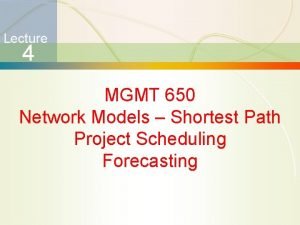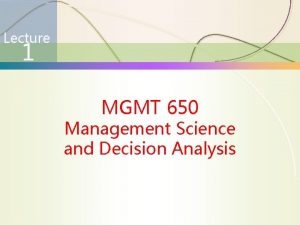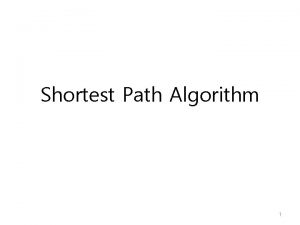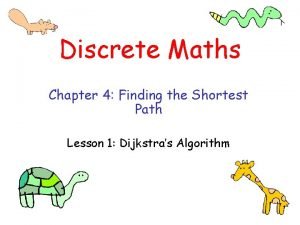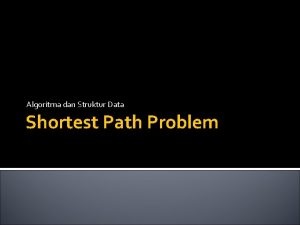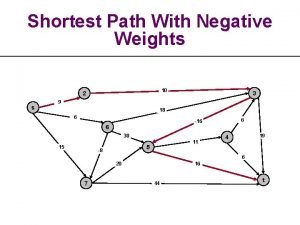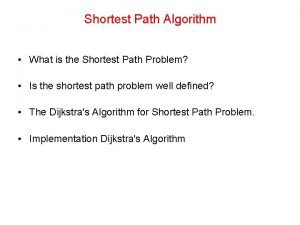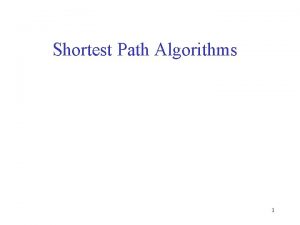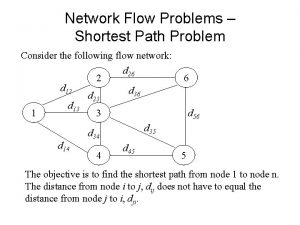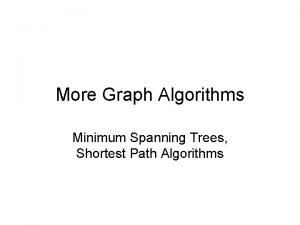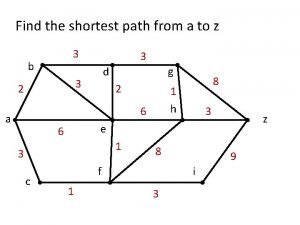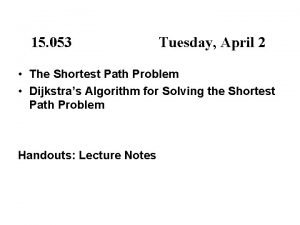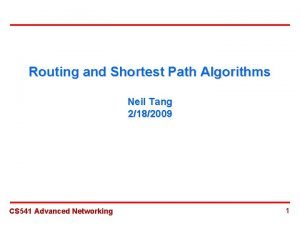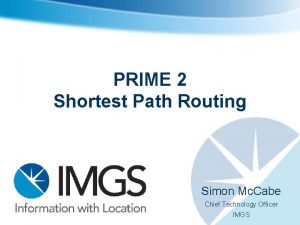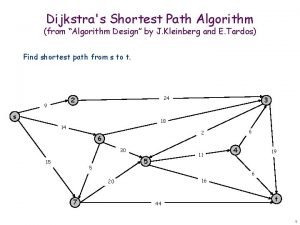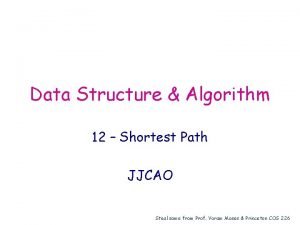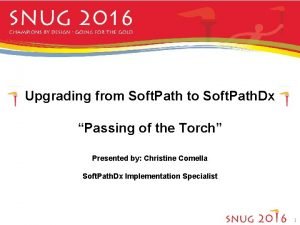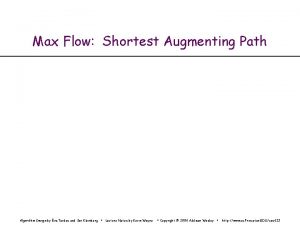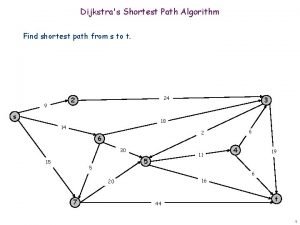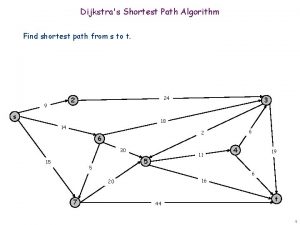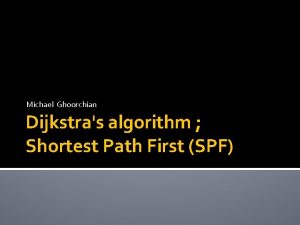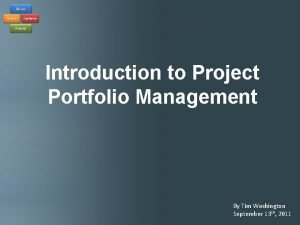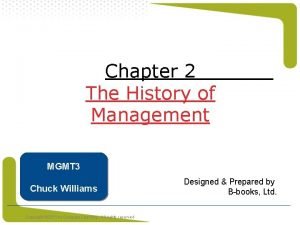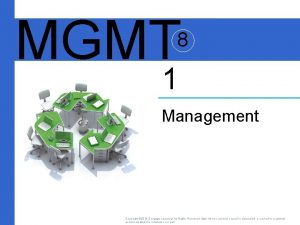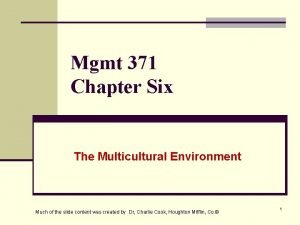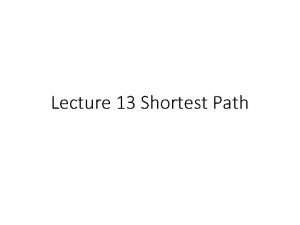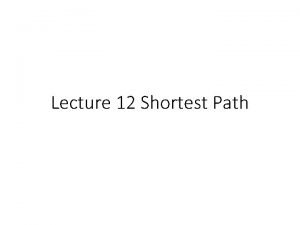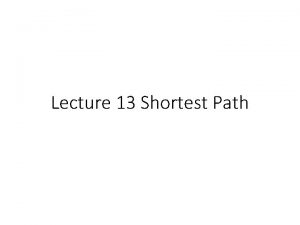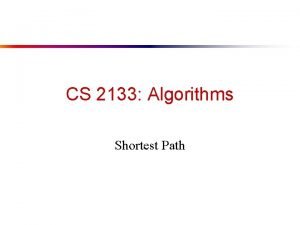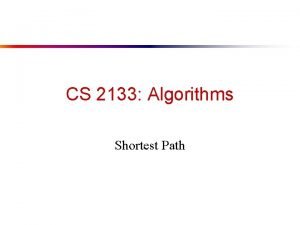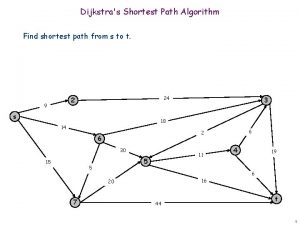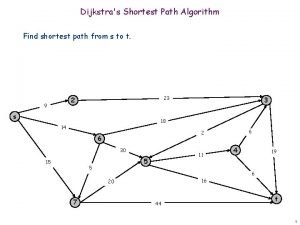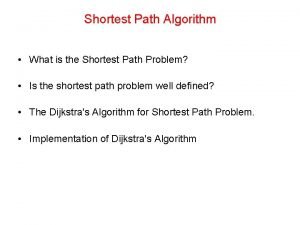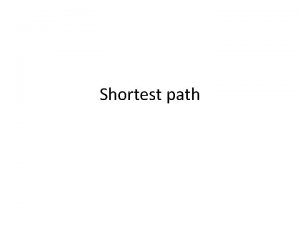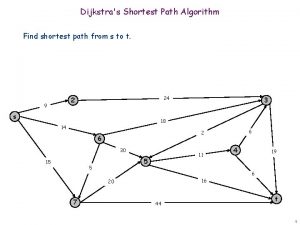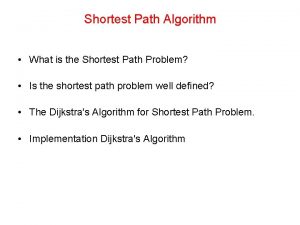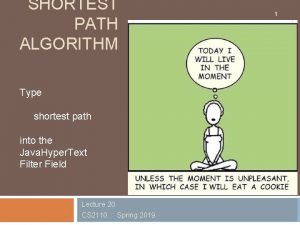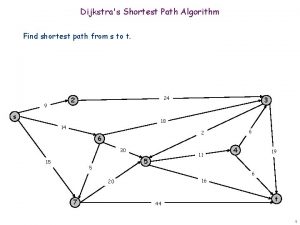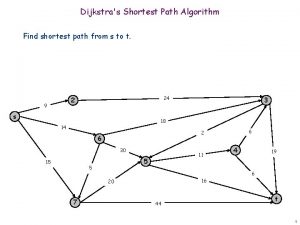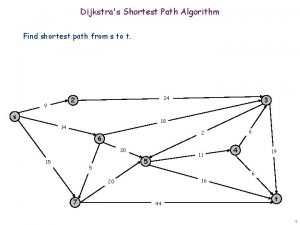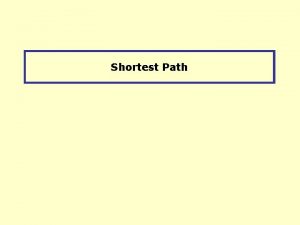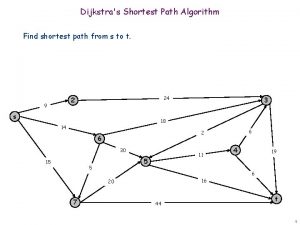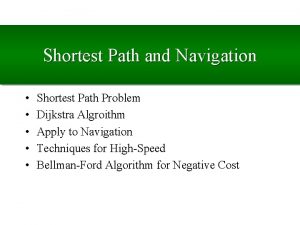Lecture 4 MGMT 650 Network Models Shortest Path









































- Slides: 41

Lecture 4 MGMT 650 Network Models – Shortest Path Project Scheduling Forecasting

Shortest Path Problem · · Belongs to class of problems typically known as network flow models What is the “best way” to traverse a network to get from one point to another as cheaply as possible? Network consists of nodes and arcs For example, consider a transportation network · · Nodes represent cities Arcs represent travel distances between cities Criterion to be minimized in the shortest path problem not limited to distance Other criteria include time and cost 2

Example: Shortest Route · Find the Shortest Route From Node 1 to All Other Nodes in the Network: 5 2 4 3 7 1 5 2 3 3 1 5 4 6 2 6 8 7 6 3

Management Scientist Input 4

Example Solution Summary Node 2 3 4 5 6 7 Minimum Distance 4 6 5 8 11 13 Shortest Route 1 -2 1 -4 -3 -5 1 -4 -3 -5 -6 -7 5

Applications · Stand alone applications · · Emergency vehicle routing Urban traffic planning Telecommunications Sub-problems in more complex settings · · Allocating inspection effort in a production line Scheduling operations Optimal equipment replacement policies Personnel planning problem 6

Optimal Equipment Replacement Policy · · The Erie County Medical Center allocates a portion of its budget to purchase newer and more advanced x-ray machines at the beginning of each year. As machines age, they break down more frequently and maintenance costs tend to increase. Furthermore salvage values decrease. Year Purchase Cost (`000) 1 170 2 Age Maintenance cost (`000) Salvage value (`000) 190 1 50 20 3 210 2 97 15 4 250 3 182 10 5 300 4 380 0 Determine the optimal replacement policy for ECMC · · that minimizes the total cost of buying, selling and operating the machine over a planning horizon of 5 years, such that at least one x-ray machine must be in service at all times. 7

Lecture 4 Project Scheduling Chapter 10

Project Management · How is it different? Limited time frame · Narrow focus, specific objectives · · Why is it used? Special needs · Pressures for new or improves products or services · · Definition of a project · Unique, one-time sequence of activities designed to accomplish a specific set of objectives in a limited time frame 9

Project Scheduling: PERT/CPM Project Scheduling with Known Activity Times · Project Scheduling with Uncertain Activity Times · 10

PERT/CPM · PERT · · CPM · · Program Evaluation and Review Technique Critical Path Method PERT and CPM have been used to plan, schedule, and control a wide variety of projects: R&D of new products and processes · Construction of buildings and highways · Maintenance of large and complex equipment · Design and installation of new systems · 11

PERT/CPM is used to plan the scheduling of individual activities that make up a project. · Projects may have as many as several thousand activities. · A complicating factor in carrying out the activities is that some activities depend on the completion of other activities before they can be started. · 12

PERT/CPM · Project managers rely on PERT/CPM to help them answer questions such as: What is the total time to complete the project? · What are the scheduled start and finish dates for each specific activity? · Which activities are critical? · · · must be completed exactly as scheduled to keep the project on schedule? How long can non-critical activities be delayed · before they cause an increase in the project completion time? 13

Project Network · Project network constructed to model the precedence of the activities. · Nodes represent activities · Arcs represent precedence relationships of the activities · · Critical path for the network · a path consisting of activities with zero slack 14

Planning and Scheduling Activity 0 2 4 6 8 10 12 14 16 18 20 Locate new facilities Interview staff Hire and train staff Select and order furniture Remodel and install phones Furniture setup Move in/startup 15

Project Network – An Example 8 weeks Locate facilities A 6 weeks Order furniture B 11 weeks Remodel E S 4 weeks Interview C 3 weeks Furniture setup F G Move in 1 week 9 weeks Hire and train D 16

Management Scientist Solution Critical Path 17

Uncertain Activity Times · Three-time estimate approach · · the time to complete an activity assumed to follow a Beta distribution An activity’s mean completion time is: t = (a + 4 m + b)/6 · · · a = the optimistic completion time estimate b = the pessimistic completion time estimate m = the most likely completion time estimate · An activity’s completion time variance is 2 = ((b-a)/6)2 18

Uncertain Activity Times In the three-time estimate approach, the critical path is determined as if the mean times for the activities were fixed times. · The overall project completion time is assumed to have a normal distribution · with mean equal to the sum of the means along the critical path, and · variance equal to the sum of the variances along the critical path. · 19

Example Immediate Activity Predecessor Optimistic Time (a) Most Likely Time (m) Pessimistic Time (b) A -- 4 6 8 B -- 1 4. 5 5 C A 3 3 3 D A 4 5 6 E A 0. 5 1 1. 5 F B, C 3 4 5 G B, C 1 1. 5 5 H E, F 5 6 7 I E, F 2 5 8 J D, H 2. 5 2. 75 4. 5 K G, I 3 5 7 20

Management Scientist Solution 21

Key Terminology · Network activities ES: early start · EF: early finish · LS: late start · LF: late finish · · Used to determine Expected project duration · Slack time · Critical path · 22

Example: Two Machine Maintenance Project Immediate Completion Activity Description Predecessors Time (wks) A Overhaul machine I --7 B Adjust machine I A 3 C Overhaul machine II --6 D Adjust machine II C 3 E Test system B, D 2 A 0 7 B 7 10 7 7 3 10 0 7 Start C 0 6 D 6 6 7 3 1 9 7 10 E 10 12 2 10 12

Normal Costs and Crash Costs Activity Normal Time Normal Cost ($) Crash Time Crash Cost ($) Maximum Reduction in Time Crash Cost per day ($) (800 -500)/3 A Overhaul Machine I 7 500 4 800 3 = 100 B Adjust machine I 3 200 2 350 1 150 C Overhaul Machine II 6 500 4 900 2 200 D Adjust machine II 3 200 1 500 2 150 E Test System 2 300 1 550 1 250 24

Linear Program for Minimum-Cost Crashing Let: Xi = earliest finish time for activity i Yi = the amount of time activity i is crashed 10 variables, 12 constraints Crash activity A by 2 days Crash activity D by 1 day Crash cost = 200 + 150 = $350 Crash activity A by 1 day Crash activity E by 1 day Crash cost = 100 + 250 = $350

Lecture 4 Forecasting Chapter 16

Forecasting - Topics · Quantitative Approaches to Forecasting · The Components of a Time Series · Measures of Forecast Accuracy · Using Smoothing Methods in Forecasting · Using Trend Projection in Forecasting 27

Time Series Forecasts Trend - long-term movement in data · Seasonality - short-term regular variations in data · Cycle – wavelike variations of more than one year’s duration · Irregular variations - caused by unusual circumstances · 28

Forecast Variations Irregular variation Trend Cycles 90 89 88 Seasonal variations 29

Smoothing/Averaging Methods Used in cases in which the time series is fairly stable and has no significant trend, seasonal, or cyclical effects · Purpose of averaging - to smooth out the irregular components of the time series. · Four common smoothing/averaging methods are: · Moving averages · Weighted moving averages · Exponential smoothing · 30

Example of Moving Average n n Sales of gasoline for the past 12 weeks at your local Chevron (in ‘ 000 gallons). If the dealer uses a 3 -period moving average to forecast sales, what is the forecast for Week 13? Past Sales Week Sales 1 17 2 21 3 19 4 23 5 18 6 16 Week 7 8 9 10 11 12 Sales 20 18 22 20 15 22

Management Scientist Solutions MA(3) for period 4 = (17+21+19)/3 = 19 Forecast error for period 3 = Actual – Forecast = 23 – 19 = 4 32

MA(5) versus MA(3) 33

Exponential Smoothing • Premise - The most recent observations might have the highest predictive value. · Therefore, we should give more weight to the more recent time periods when forecasting. Ft+1 = Ft + (At - Ft), Formula 16. 3 34

Linear Trend Equation Suitable for time series data that exhibit a long term linear trend Ft Ft = a + bt a · · 0 1 2 Ft = Forecast for period t t = Specified number of time periods a = Value of Ft at t = 0 b = Slope of the line 3 4 5 t 35

Linear Trend Example Linear trend equation F 11 = 20. 4 + 1. 1(11) = 32. 5 Sale increases every time period @ 1. 1 units 36

Actual vs Forecast Actual/Forecasted sales Linear Trend Example 35 30 25 20 Actual 15 Forecast 10 5 0 1 2 3 4 5 6 7 8 9 10 Week F(t) = 20. 4 + 1. 1 t 37

Measure of Forecast Accuracy · MSE = Mean Squared Error 38

Forecasting with Trends and Seasonal Components – An Example · · · Business at Terry's Tie Shop can be viewed as falling into three distinct seasons: (1) Christmas (November-December); (2) Father's Day (late May - mid-June); and (3) all other times. Average weekly sales ($) during each of the three seasons during the past four years are known and given below. Determine a forecast for the average weekly sales in year 5 for each of the three seasons. Year Season 1 2 3 4 1 1856 1995 2241 2280 2 2012 2168 2306 2408 3 985 1072 1105 1120 39

Management Scientist Solutions 40

Interpretation of Seasonal Indices · Seasonal index for season 2 (Father’s Day) = 1. 236 · · Means that the sale value of ties during season 2 is 23. 6% higher than the average sale value over the year Seasonal index for season 3 (all other times) = 0. 586 · Means that the sale value of ties during season 3 is 41. 4% lower than the average sale value over the year 41
 Mgmt 650 quiz 4
Mgmt 650 quiz 4 Locational break even analysis
Locational break even analysis Shortest path to get food
Shortest path to get food Shortest path problem linear programming
Shortest path problem linear programming Algorithm definition
Algorithm definition Dijkstra's shortest path algorithm pseudocode
Dijkstra's shortest path algorithm pseudocode Shortest path problems in discrete mathematics
Shortest path problems in discrete mathematics Shortest path problem adalah
Shortest path problem adalah Tramp steamer problem
Tramp steamer problem Dijkstra's algorithm table
Dijkstra's algorithm table Widest path problem dijkstra
Widest path problem dijkstra Dijkstra algorithm
Dijkstra algorithm Shortest path from source to destination in weighted graph
Shortest path from source to destination in weighted graph Single source shortest path in c
Single source shortest path in c Shortest path problem excel
Shortest path problem excel Minimum spanning tree shortest path
Minimum spanning tree shortest path Find the shortest path from a to z
Find the shortest path from a to z Minimum cost flow
Minimum cost flow Neil tang
Neil tang Fme shortest path finder
Fme shortest path finder Shortest path
Shortest path How to find the shortest path
How to find the shortest path Pathdx
Pathdx Shortest path bridging
Shortest path bridging Mincost flow
Mincost flow Augmenting paths
Augmenting paths Shortest path algorithm in mapreduce
Shortest path algorithm in mapreduce Shortest path
Shortest path Shortest path
Shortest path Dijkestra
Dijkestra 01:640:244 lecture notes - lecture 15: plat, idah, farad
01:640:244 lecture notes - lecture 15: plat, idah, farad Infrastructure mgmt
Infrastructure mgmt Tim washington portfolio mgmt
Tim washington portfolio mgmt Chapter 2 history of management
Chapter 2 history of management Mgmt 4
Mgmt 4 Mgmt 371
Mgmt 371 Mgmt+8
Mgmt+8 Mgmt 371
Mgmt 371 Keller graduate school of mgmt
Keller graduate school of mgmt Mgmt 341
Mgmt 341 Mgmt 371 final exam
Mgmt 371 final exam Mgmt ama
Mgmt ama
